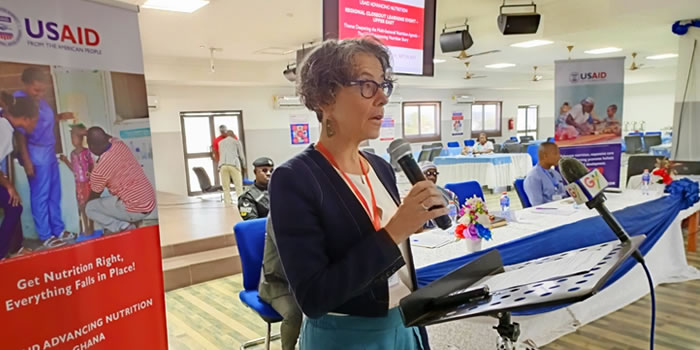

SOCIAL
Stunting among children remains high in Northern Ghana – USAID
Madam Maureen Malave, the Nutrition and Social Protection Lead, United States Agency for International Development (USAID), says stunting among children in northern Ghana is too high.

Date Created : 9/22/2023 : Story Author : Godfred A.Polkuu/ Ghanadistricts.com
Even though the country had made progress in health over the past decades, the nutrition status of children below five years remained a concern. She referenced Ghana’s 2022 Demographic Health Survey and indicated that the rate of stunting (low height for age) was at 18 per cent, compared to 19 per cent in 2014, and wasting (low weight for height) increased from five per cent in 2014 to six per cent in 2022.
“Stunting remains particularly high in the northern regions - peaking at 30 per cent in the Northern Region and 29 per cent in the North-East Region,” Madam Malave said at the close of the USAID Advancing Nutrition project in Bolgatanga.
She said the project was the Agency’s flagship multi-sectoral nutrition programme, which addressed the root causes of malnutrition to save lives and enhance long-term health and development.
The project was implemented in 2020 in 55 municipalities and districts across the Upper East Region, North-East, Savannah, Upper West and Northern regions. The beneficiary districts in the Upper East Region include Bawku West, Garu, Tempane, and the Bawku Municipality.
The project provided technical support to advance the Government of Ghana’s efforts to improve planning and delivery of services that promoted household resilience and early childhood growth and development.
The closing ceremony, dubbed: ‘Regional Closeout Learning Event,’ was on the theme: “Deepening the Multi-sectoral Nutrition Agenda; The USAID Advancing Nutrition Story.” Madam Malave, who highlighted some achievements of the project over the three-year period, said more than 250,000 children below age five years and 120,000 pregnant women were reached with nutrition services.
These included monthly growth monitoring through the Agency’s support to the Ghana Health Service (GHS). “More than 5,000 health workers were trained in nutrition service delivery, including promoting infant and young child feeding, anemia prevention and control, and community management of acute malnutrition,” she said.
The Team Lead said they worked with the National Development Planning Commission to develop guidelines for food and nutrition security and trained staff at the regional and district levels on the guidelines. That, she noted, was critical to ensuring that districts made conscious and guided efforts to incorporate food and nutrition security into their medium-term development plans.
“Through this project, we will continue to support health workers to improve service delivery and counseling related to infant and young child feeding, anemia prevention and control, management of severe acute malnutrition, and community-based nutrition services.” Madam Malave said poor nutrition had adverse consequences for child survival, long-term well-being and far-reaching consequences for human capital, economic productivity, and national development overall.
The USAID would continue to work with the GHS to advocate the inclusion of nutrition commodities in the Essential Medicines List and the same covered under the National Health Insurance Scheme, she said.
Mr Stephen Yakubu, the Upper East Regional Minister, who officially closed the project, said the USAID had partnered the region in diverse ways for development, and was one of the critical development partners. “I, therefore, want to use this opportunity to commend it for the tremendous interventions in the areas of governance, peace and security, agriculture and health,” he said.










 facebook
facebook
 twitter
twitter
 Youtube
Youtube
 +233 593 831 280
+233 593 831 280 0800 430 430
0800 430 430 GPS: GE-231-4383
GPS: GE-231-4383 info@ghanadistricts.com
info@ghanadistricts.com Box GP1044, Accra, Ghana
Box GP1044, Accra, Ghana